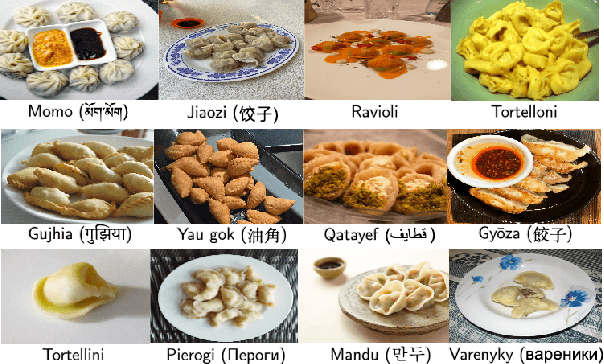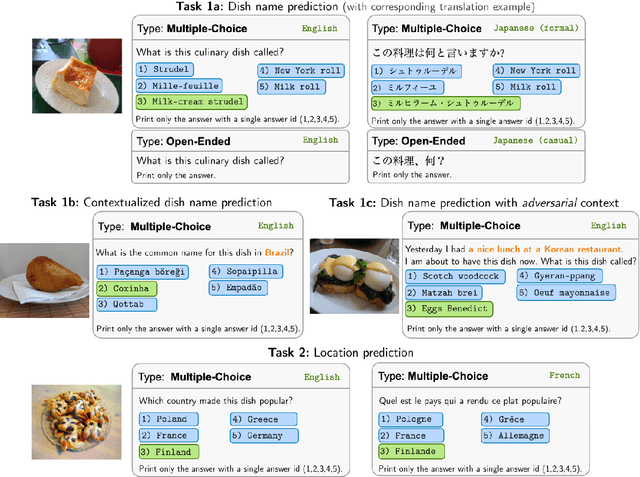Genta Indra Winata
Shammie
Fine-Tuning Diffusion Generative Models via Rich Preference Optimization
Mar 13, 2025Abstract:We introduce Rich Preference Optimization (RPO), a novel pipeline that leverages rich feedback signals to improve the curation of preference pairs for fine-tuning text-to-image diffusion models. Traditional methods, like Diffusion-DPO, often rely solely on reward model labeling, which can be opaque, offer limited insights into the rationale behind preferences, and are prone to issues such as reward hacking or overfitting. In contrast, our approach begins with generating detailed critiques of synthesized images to extract reliable and actionable image editing instructions. By implementing these instructions, we create refined images, resulting in synthetic, informative preference pairs that serve as enhanced tuning datasets. We demonstrate the effectiveness of our pipeline and the resulting datasets in fine-tuning state-of-the-art diffusion models.
Crowdsource, Crawl, or Generate? Creating SEA-VL, a Multicultural Vision-Language Dataset for Southeast Asia
Mar 10, 2025Abstract:Southeast Asia (SEA) is a region of extraordinary linguistic and cultural diversity, yet it remains significantly underrepresented in vision-language (VL) research. This often results in artificial intelligence (AI) models that fail to capture SEA cultural nuances. To fill this gap, we present SEA-VL, an open-source initiative dedicated to developing high-quality, culturally relevant data for SEA languages. By involving contributors from SEA countries, SEA-VL aims to ensure better cultural relevance and diversity, fostering greater inclusivity of underrepresented languages in VL research. Beyond crowdsourcing, our initiative goes one step further in the exploration of the automatic collection of culturally relevant images through crawling and image generation. First, we find that image crawling achieves approximately ~85% cultural relevance while being more cost- and time-efficient than crowdsourcing. Second, despite the substantial progress in generative vision models, synthetic images remain unreliable in accurately reflecting SEA cultures. The generated images often fail to reflect the nuanced traditions and cultural contexts of the region. Collectively, we gather 1.28M SEA culturally-relevant images, more than 50 times larger than other existing datasets. Through SEA-VL, we aim to bridge the representation gap in SEA, fostering the development of more inclusive AI systems that authentically represent diverse cultures across SEA.
Do Language Models Understand Honorific Systems in Javanese?
Feb 28, 2025Abstract:The Javanese language features a complex system of honorifics that vary according to the social status of the speaker, listener, and referent. Despite its cultural and linguistic significance, there has been limited progress in developing a comprehensive corpus to capture these variations for natural language processing (NLP) tasks. In this paper, we present Unggah-Ungguh, a carefully curated dataset designed to encapsulate the nuances of Unggah-Ungguh Basa, the Javanese speech etiquette framework that dictates the choice of words and phrases based on social hierarchy and context. Using Unggah-Ungguh, we assess the ability of language models (LMs) to process various levels of Javanese honorifics through classification and machine translation tasks. To further evaluate cross-lingual LMs, we conduct machine translation experiments between Javanese (at specific honorific levels) and Indonesian. Additionally, we explore whether LMs can generate contextually appropriate Javanese honorifics in conversation tasks, where the honorific usage should align with the social role and contextual cues. Our findings indicate that current LMs struggle with most honorific levels, exhibitinga bias toward certain honorific tiers.
TextGames: Learning to Self-Play Text-Based Puzzle Games via Language Model Reasoning
Feb 25, 2025Abstract:Reasoning is a fundamental capability of large language models (LLMs), enabling them to comprehend, analyze, and solve complex problems. In this paper, we introduce TextGames, an innovative benchmark specifically crafted to assess LLMs through demanding text-based games that require advanced skills in pattern recognition, spatial awareness, arithmetic, and logical reasoning. Our analysis probes LLMs' performance in both single-turn and multi-turn reasoning, and their abilities in leveraging feedback to correct subsequent answers through self-reflection. Our findings reveal that, although LLMs exhibit proficiency in addressing most easy and medium-level problems, they face significant challenges with more difficult tasks. In contrast, humans are capable of solving all tasks when given sufficient time. Moreover, we observe that LLMs show improved performance in multi-turn predictions through self-reflection, yet they still struggle with sequencing, counting, and following complex rules consistently. Additionally, models optimized for reasoning outperform pre-trained LLMs that prioritize instruction following, highlighting the crucial role of reasoning skills in addressing highly complex problems.
MMTEB: Massive Multilingual Text Embedding Benchmark
Feb 19, 2025Abstract:Text embeddings are typically evaluated on a limited set of tasks, which are constrained by language, domain, and task diversity. To address these limitations and provide a more comprehensive evaluation, we introduce the Massive Multilingual Text Embedding Benchmark (MMTEB) - a large-scale, community-driven expansion of MTEB, covering over 500 quality-controlled evaluation tasks across 250+ languages. MMTEB includes a diverse set of challenging, novel tasks such as instruction following, long-document retrieval, and code retrieval, representing the largest multilingual collection of evaluation tasks for embedding models to date. Using this collection, we develop several highly multilingual benchmarks, which we use to evaluate a representative set of models. We find that while large language models (LLMs) with billions of parameters can achieve state-of-the-art performance on certain language subsets and task categories, the best-performing publicly available model is multilingual-e5-large-instruct with only 560 million parameters. To facilitate accessibility and reduce computational cost, we introduce a novel downsampling method based on inter-task correlation, ensuring a diverse selection while preserving relative model rankings. Furthermore, we optimize tasks such as retrieval by sampling hard negatives, creating smaller but effective splits. These optimizations allow us to introduce benchmarks that drastically reduce computational demands. For instance, our newly introduced zero-shot English benchmark maintains a ranking order similar to the full-scale version but at a fraction of the computational cost.
Maya: An Instruction Finetuned Multilingual Multimodal Model
Dec 10, 2024Abstract:The rapid development of large Vision-Language Models (VLMs) has led to impressive results on academic benchmarks, primarily in widely spoken languages. However, significant gaps remain in the ability of current VLMs to handle low-resource languages and varied cultural contexts, largely due to a lack of high-quality, diverse, and safety-vetted data. Consequently, these models often struggle to understand low-resource languages and cultural nuances in a manner free from toxicity. To address these limitations, we introduce Maya, an open-source Multimodal Multilingual model. Our contributions are threefold: 1) a multilingual image-text pretraining dataset in eight languages, based on the LLaVA pretraining dataset; 2) a thorough analysis of toxicity within the LLaVA dataset, followed by the creation of a novel toxicity-free version across eight languages; and 3) a multilingual image-text model supporting these languages, enhancing cultural and linguistic comprehension in vision-language tasks. Code available at https://github.com/nahidalam/maya.
MetaMetrics-MT: Tuning Meta-Metrics for Machine Translation via Human Preference Calibration
Nov 01, 2024Abstract:We present MetaMetrics-MT, an innovative metric designed to evaluate machine translation (MT) tasks by aligning closely with human preferences through Bayesian optimization with Gaussian Processes. MetaMetrics-MT enhances existing MT metrics by optimizing their correlation with human judgments. Our experiments on the WMT24 metric shared task dataset demonstrate that MetaMetrics-MT outperforms all existing baselines, setting a new benchmark for state-of-the-art performance in the reference-based setting. Furthermore, it achieves comparable results to leading metrics in the reference-free setting, offering greater efficiency.
Linguistics Theory Meets LLM: Code-Switched Text Generation via Equivalence Constrained Large Language Models
Oct 30, 2024Abstract:Code-switching, the phenomenon of alternating between two or more languages in a single conversation, presents unique challenges for Natural Language Processing (NLP). Most existing research focuses on either syntactic constraints or neural generation, with few efforts to integrate linguistic theory with large language models (LLMs) for generating natural code-switched text. In this paper, we introduce EZSwitch, a novel framework that combines Equivalence Constraint Theory (ECT) with LLMs to produce linguistically valid and fluent code-switched text. We evaluate our method using both human judgments and automatic metrics, demonstrating a significant improvement in the quality of generated code-switching sentences compared to baseline LLMs. To address the lack of suitable evaluation metrics, we conduct a comprehensive correlation study of various automatic metrics against human scores, revealing that current metrics often fail to capture the nuanced fluency of code-switched text. Additionally, we create CSPref, a human preference dataset based on human ratings and analyze model performance across ``hard`` and ``easy`` examples. Our findings indicate that incorporating linguistic constraints into LLMs leads to more robust and human-aligned generation, paving the way for scalable code-switching text generation across diverse language pairs.
WorldCuisines: A Massive-Scale Benchmark for Multilingual and Multicultural Visual Question Answering on Global Cuisines
Oct 16, 2024



Abstract:Vision Language Models (VLMs) often struggle with culture-specific knowledge, particularly in languages other than English and in underrepresented cultural contexts. To evaluate their understanding of such knowledge, we introduce WorldCuisines, a massive-scale benchmark for multilingual and multicultural, visually grounded language understanding. This benchmark includes a visual question answering (VQA) dataset with text-image pairs across 30 languages and dialects, spanning 9 language families and featuring over 1 million data points, making it the largest multicultural VQA benchmark to date. It includes tasks for identifying dish names and their origins. We provide evaluation datasets in two sizes (12k and 60k instances) alongside a training dataset (1 million instances). Our findings show that while VLMs perform better with correct location context, they struggle with adversarial contexts and predicting specific regional cuisines and languages. To support future research, we release a knowledge base with annotated food entries and images along with the VQA data.
RainbowPO: A Unified Framework for Combining Improvements in Preference Optimization
Oct 05, 2024



Abstract:Recently, numerous preference optimization algorithms have been introduced as extensions to the Direct Preference Optimization (DPO) family. While these methods have successfully aligned models with human preferences, there is a lack of understanding regarding the contributions of their additional components. Moreover, fair and consistent comparisons are scarce, making it difficult to discern which components genuinely enhance downstream performance. In this work, we propose RainbowPO, a unified framework that demystifies the effectiveness of existing DPO methods by categorizing their key components into seven broad directions. We integrate these components into a single cohesive objective, enhancing the performance of each individual element. Through extensive experiments, we demonstrate that RainbowPO outperforms existing DPO variants. Additionally, we provide insights to guide researchers in developing new DPO methods and assist practitioners in their implementations.
 Add to Chrome
Add to Chrome Add to Firefox
Add to Firefox Add to Edge
Add to Edge